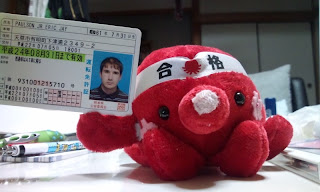It occurred to me after my last post that I never explained exactly why I needed to get a Japanese license in the first place. After all, I already have a license and have been using it in Japan for just under a year now. This is actually a really important issue if you ever intend on working, and driving, in Japan, so I’ll do my best to explain what I know about it.
The Geneva Convention established, among other things, a list of countries which all agreed to honor one another’s licenses for a period of a year from the date of issue of an international driver’s permit. In America, these permits can only be received from a few authorized places. I’ve heard there are several other unauthorized groups that attempt to scam people, too, so be cautious. I got mine from AAA just before leaving for Japan. They were kind enough to post-date my permit by a few days, as I wouldn’t have to start driving immediately and wanted as much time as possible to use it. My last day would be July 29th, 2010. It’s like a time bomb, only much more boring.
The way the permit works is basically by vouching for your American license, meaning that the two have to be together at all times. This may prove troublesome if, say, you usually leave the permit in your glove box and then drive your friend’s car on a trip from a village three hours away. The size of the permit doesn’t help either, as it won’t easily fir into a pocket or wallet.
So, after one year, everyone who drives using an international permit has to acquire a Japanese one. But not everyone has to go through the same process. Actually, America is one of the few countries that has to take the driving test. Foreigners from other places, like Canada and England, only go in for an eye exam and switch over their licenses. This is because either a) they have a national driving test system that meets with Japan’s approval or b) they completed a survey of their various driving test requirements and that met with Japan’s approval. America could conduct a similar survey of all 50 states’ driving test requirements and spare those living abroad the burdensome task of having to prove to the Japanese driving instructors that they can indeed drive safely. Unfortunately, I think there are too few Americans living in this country for the government to bother with it. In addition, one of the stipulations of the survey is reciprocity, meaning allowing the Japanese living in America to switch over their licenses in the same way. Though this is only fair and logical, I fear there are less progressive areas of the nation in which the stereotype of the foreigner who doesn’t know how to drive is still alive and well.
It took me four tries. FOUR TRIES! That’s four two hour trips into the city, four lectures in Japanese and broken English about every mistake I’d made (and yes, they did this even on the time I passed), and four days completely devoid of my kids or teaching, but I finally did it. This little piece of plastic represents an investment of well over $100 and a lot of hard work and guts. I’m just glad it’s over.



Doing better than me! I still don't even have my American driver license!
ReplyDeleteCongratulations on passing and getting your Japanese drivers license. I know it was frustrating but you did it.
ReplyDeletegood job
ReplyDelete